|
The "Lost Tombs" Revisited:
"Success Has a Thousand Fathers ..."
Part V
Which brings us to a discussion of Seti-Iís "Great Temple" -- which
contains the "glyphs" themselves.
From the simple physical placement of Seti-Iís Temple at Abydos,
and its radical architectural departure from all previous "Egyptian
temple plans" (in a highly conservative society, where nothing was
changed without an over-whelming reason!), it is apparent that
Seti-Iís "standard" architectural design was abruptly altered ...
for "an overwhelming reason." Omm Sety explains:
"... it must be pointed out that there are some unique features
(apart from the exquisite perfection of its sculpture) which set
[this Temple] apart from any other Egyptian temple.
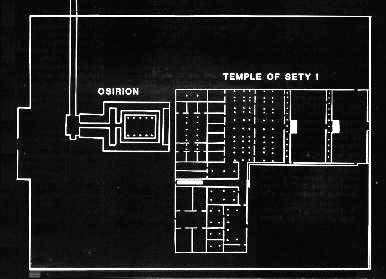 "First of all, the plan of the building is not the customary
rectangle but is shaped like a capital letter íLí (right). But this
does not seem to have been premeditated. The width of the short arm
of the íLí is exactly the width of the main part. Moreover, the
chambers in it should normally be at the extreme western end of
the building behind what is now called the íOsiris Complex.í
Furthermore, the thickness of the wall dividing the Chapel of Sety,
and the chapels of the Statue Hall from the Hall of Soker and its
chapels is the same as that of the outer southern wall of the two
hypostyle halls and the two courts. In other words, that was the
original southern exterior wall of the building; and all of the
rooms to the south of it [the lower part of the íLí -- above] are
additions. "First of all, the plan of the building is not the customary
rectangle but is shaped like a capital letter íLí (right). But this
does not seem to have been premeditated. The width of the short arm
of the íLí is exactly the width of the main part. Moreover, the
chambers in it should normally be at the extreme western end of
the building behind what is now called the íOsiris Complex.í
Furthermore, the thickness of the wall dividing the Chapel of Sety,
and the chapels of the Statue Hall from the Hall of Soker and its
chapels is the same as that of the outer southern wall of the two
hypostyle halls and the two courts. In other words, that was the
original southern exterior wall of the building; and all of the
rooms to the south of it [the lower part of the íLí -- above] are
additions.
"The reason for this change of plan is, as we have seen,
the rediscovery [by Setiís architects] of the Osirion. Had the temple
been continued westward, as it should have been, it would have
covered the roof of the [much!] older building (see above). This was
something the architect [apparently] wanted to avoid at all costs.
[By this expensive and radical last-minute alteration, Seti was
tacitly acknowledging that] the Osirion was by no means just one of
those [other] old temples to be built on [emphasis added] ..!"
Which, apart from the discovery of the potentially
revolutionary
"glyphs" themselves inside, brings us to the first of several
fundamental questions re the "Temple of Seti-I":
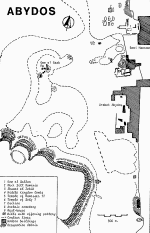 How likely is it that
Seti (or his architects) did NOT know of the
existence of the Osirion before construction was begun? Out of all
of Abydos to choose from
(click image left), how did they
unerringly plan to
build Setiís "pride and joy" on the exact same site as "one of the
great puzzles of Egyptian archaeology" -- the long buried and
forgotten, obviously highly revered and mysterious "Osirion" --
purely by chance?! How likely is it that
Seti (or his architects) did NOT know of the
existence of the Osirion before construction was begun? Out of all
of Abydos to choose from
(click image left), how did they
unerringly plan to
build Setiís "pride and joy" on the exact same site as "one of the
great puzzles of Egyptian archaeology" -- the long buried and
forgotten, obviously highly revered and mysterious "Osirion" --
purely by chance?!
Omm Sety has the answer:
"... in normal temples of this period, the roofs of the various
halls become lower as one penetrates further into the building. This
temple, being built on rising ground, has the same effect but
obtained by a reverse process. Instead of the roof being lowered,
the ground is gradually raised, and it is not until we reach the
extreme western end of the building that the actual roof is lowered.
"This arrangement, entailing the leveling and banking of the
different planes, must have meant an enormous amount of [expensive!]
hard work before a foundation block was ever set in place. As there
were plenty of level sites in Abydos, it bears out the statement
made by Sety that the temple was built in accordance with the
demands of a divine oracle. This may also explain why Sety abandoned
the traditional temple site at Kom el Sultan (which must have been
very overcrowded by this time). So far as we know, this was the
first temple to be built outside the great Temenos of Osiris
[emphasis added] ..."
From this architectural analysis, and his own oblique reference to
"oracles," it is very likely then that at least Seti-I himself
somehow had "inside" knowledge of where the long-forgotten Osirion
was buried. He then deliberately planned (Egyptological opinion
notwithstanding) to build his Temple in ultra-close association [see
below where the Western Wall of Setiís Temple (top) is clearly
abutting the now-excavated Osirion (foreground)].
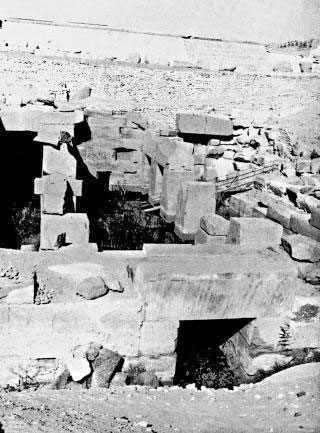 The reason is also
quite obvious: close proximity to a previous
"sacred complex" dedicated to Osiris -- perchance, to
Osiris "burial
tomb" itself! -- would (via sympathetic "magic") only enhance Setiís
own "connection" to Osiris. And it was on that connection that the
well-being of the entire Kingdom, according to Egyptian beliefs,
ultimately depended ... The reason is also
quite obvious: close proximity to a previous
"sacred complex" dedicated to Osiris -- perchance, to
Osiris "burial
tomb" itself! -- would (via sympathetic "magic") only enhance Setiís
own "connection" to Osiris. And it was on that connection that the
well-being of the entire Kingdom, according to Egyptian beliefs,
ultimately depended ...
So, why didnít Seti-I inform his own architects of such a plan?
Since, it is equally obvious, they were forced to make sudden,
last-minute (and somewhat clumsy) changes to their own architectural
plans -- to prevent incursion of Seti-Iís "Great Temple" into
Osirisí "sacred space" - when the latter was 'rediscovered' in the
course of the construction.
The ultimate answer may never be known. But, it could easily lie in
intrigues and power plays within the lifelong Abydos Priesthood vis
a vis the 'secular' wishes of the Pharaoh (the priests would have
told him "NO!", if they got wind of what he planned to do
- before
the "accidental" rediscovery); or, it may have involved arcane and
internecine fights within Setiís own palace retinue ... or even, a
specific injunction against telling anyone - delivered by Setiís
"divine oracle" itself!
(After all, many reports are surfacing of similar, modern
"visitations," and the delivery of equally arcane "messages" ...
some to the heads of major world-class corporations -- such as that
claimed recently by Joseph Firmage, when he ran US Web ...)
Whatever the real "source" of Setiís prior knowledge, his decision
NOT to simultaneously inform his architects forced their obviously
unprepared, last-minute alteration of his Templeís architecture to
accommodate the Osirionís sudden rediscovery: "this imposing,
fascinating, mysterious building of bewildering charm ..." This, in
turn, would serendipitously reveal the presence of this amazing
structure once again - thousands of years later... to the 20th
Century itself, when Egyptologists began seriously exploring the
immediate environs of Setiís own, much younger Temple ...
These ambiguous events surrounding Setiís choice of a building site,
though initially contradictory and confusing, are in fact remarkably
consistent with Seti-Iís lifelong actions vis a vis Egyptís Sacred
Traditions of the Past. For--
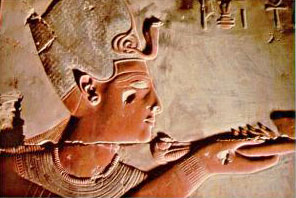 "When he became King,
Sety (right from his Temple) chose as one of
his official names, Wehem-musut, which means, íRepeating Births,í
or, in other words, íRenaissanceí; and this name was a proclamation
of his policy. For Sety had inherited a kingdom riddled with
corruption despite the unceasing efforts of Hor-em-heb to clean up
the government departments. Egyptís Asiatic Empire had vanished, her
frontiers were threatened and even her ago-old claim on the Sinai
Peninsula was disputed by roving bands ... "When he became King,
Sety (right from his Temple) chose as one of
his official names, Wehem-musut, which means, íRepeating Births,í
or, in other words, íRenaissanceí; and this name was a proclamation
of his policy. For Sety had inherited a kingdom riddled with
corruption despite the unceasing efforts of Hor-em-heb to clean up
the government departments. Egyptís Asiatic Empire had vanished, her
frontiers were threatened and even her ago-old claim on the Sinai
Peninsula was disputed by roving bands ...
"Setyís policy of Renaissance aimed at the full restoration of
internal law and order, regaining the lost Empire and stamping out
all memory of the unorthodox íHeresy Periodí [Akhen-Atonís reign
...] that had preceded Hor-em-hebís coup ...
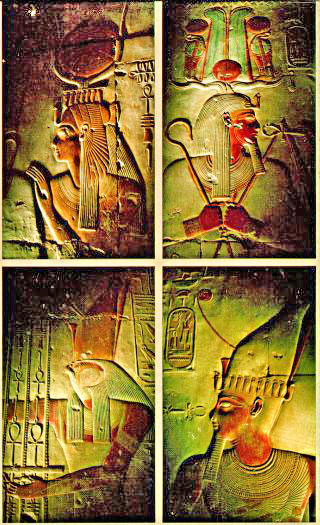 "Thus most of the first half of Setyís twenty-one year reign was
occupied in settling the unrest in the Middle East. Only then did he
feel free to embark on his great building schemes ... To him we owe
the completion of the building of the great hypostle hall at Karnak
(begun by Hor-em-heb), the Temple of Gourna and additions to many
existing temples. But his greatest artistic triumph into which he
had put his whole heart, soul and energy is his beautiful temple at
Abydos (left). The whole building stands as witness to his reverence
for the gods and his love of sheer beauty ... "Thus most of the first half of Setyís twenty-one year reign was
occupied in settling the unrest in the Middle East. Only then did he
feel free to embark on his great building schemes ... To him we owe
the completion of the building of the great hypostle hall at Karnak
(begun by Hor-em-heb), the Temple of Gourna and additions to many
existing temples. But his greatest artistic triumph into which he
had put his whole heart, soul and energy is his beautiful temple at
Abydos (left). The whole building stands as witness to his reverence
for the gods and his love of sheer beauty ...
"Sety also restored many ancient, ruined monuments ... It is
characteristic of Sety that in all these restorations [unlike many
other pharaohs] he never attempted to claim an older monument as his
own but merely added modestly, and almost timidly, small hieroglyphs
that it had been restored by his orders ..."
From which Henri Frankfort saddled the world with the major
misimpression ... that Seti-I built the mysterious "Osirion" --
when, in fact, by placing his own Temple right up against it, and
doing minor "fix up when he found it, Seti obviously "only" sought
to attach its ancient "magic" to his own ...
"Magic" which extended to the interior of his own Temple ... and a
set of enigmatic "glyphs" depicting more objects definitely not of
his own time ...
Earlier, we mentioned the continuing debate over the potential
reality of Osiris as an historic entity:
was he an actual, early "civilizing figure" in Egyptís long
pre-dynastic past -- later deified (like "Imhotep," IIIrd Dynasty
architect of the Stepped Pyramid at Saqqara) for his remarkable
accomplishments? Or, did the Egyptian priesthood cleverly camouflage
a set of "deeper" truths and meta-physics within this set of
endlessly retold "Osiris myths" about an ancient murdered leader ...
inextricably
interweaving "esoteric knowledge" and a literally "hidden history"
in the surficially simple tales of "Osiris/Isis," "Set" and "Horus?"
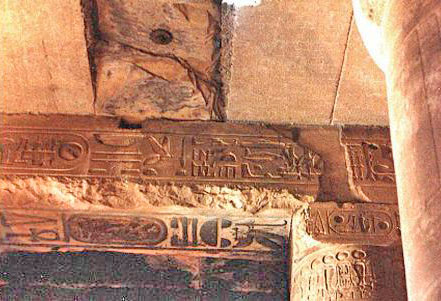
Others, far more expert than I, have investigated aspects of the
latter possibility and decided that itís true: the Egyptians were
concealing "secrets" only the "initiated" were supposed to really
know ... Schwaller de Lubicz, John Anthony West, Graham Hancock,
Alan Alford, etc., have all affirmed this view.
But, as I began investigating the Osiris Myths myself -- part of our
continuing inquiry into a potential and astonishing (because itís
current!) "Osiris Cult" in NASA -- I noticed some peculiarly
significant numbers recurring in these texts.
Numbers that seemed drawn directly from our developing model for
"Hyperdimensional Physics" itself !
 In the version of the murder where Set gathers his cohorts together
for a Feast "in honor of Osiris," and then invites the unsuspecting
god to get into a carefully guilded box (which will ultimately
become his coffin -- when itís sealed and cast into the Nile, with
him inside!), the myth makes particular reference to the number of
Setís "co-conspirators" gathered at the "Feast":
72. Not 71 ... or
73. But 72. In the version of the murder where Set gathers his cohorts together
for a Feast "in honor of Osiris," and then invites the unsuspecting
god to get into a carefully guilded box (which will ultimately
become his coffin -- when itís sealed and cast into the Nile, with
him inside!), the myth makes particular reference to the number of
Setís "co-conspirators" gathered at the "Feast":
72. Not 71 ... or
73. But 72.
Now, "72" is a highly significant "natural" number.
First and foremost, it is the number of years the Earth requires for
itís rotational axis in space to drift 1 degree (of the 360) around
a small circle projected into space, relative to distant stars
(diagram, left). The cause of this axial drift is the Earthís
ultra-slow "coning motion" completely around this 47-degree-wide
circle (twice its 23.5-degree tilt), relative to its orbit of the
sun.
Thus, to 'precess' one full circle, the Earthís axis requires 72 X
360 = 25,920 years, to completely cone once "completing one Great
Astronomical Year" somewhat like the slow wobbling of a rapidly
spinning top (diagram, right).
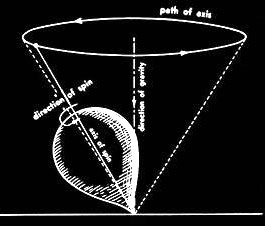 For several years, we at
'Enterprise' have been looking into a
"Hyperdimensional" reason for this fundamental motion of the Earth.
This, as opposed to the commonly accepted theory -- that it is the
Moonís simple gravitational pull, tugging on the slightly bulging
equator of the Earth, which causes its Precession (directly
analogous to the Earthís own gravity pulling down on the precessing
top). For several years, we at
'Enterprise' have been looking into a
"Hyperdimensional" reason for this fundamental motion of the Earth.
This, as opposed to the commonly accepted theory -- that it is the
Moonís simple gravitational pull, tugging on the slightly bulging
equator of the Earth, which causes its Precession (directly
analogous to the Earthís own gravity pulling down on the precessing
top).
(If that were true, with the Moon very slowly receding from the
Earth -- as verified for 30 years by the Apollo astronaut-emplaced
laser reflectors on the Moon -- the lunar gravitational influence on
Earth should be lessening as it recedes. Thus, the rate of
Precession should be slowing down, as the force of lunar gravity
causing the precession weakens. Instead, itís speeding up! The
latest NASA figures quote a period of "only" around 25,828 years ...
as opposed to the canonical 25,920. Clearly, somethingís seriously
wrong with the prevailing precessional/gravitational theory!)
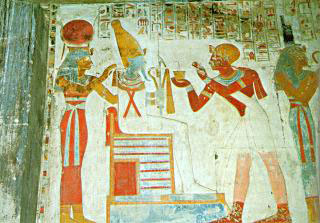 I am certainly not the first to notice the potential for hidden
'Precessional' codes and numbers in the various Osirisí Myths
(image left). I am certainly not the first to notice the potential for hidden
'Precessional' codes and numbers in the various Osirisí Myths
(image left).
Though still ignored as even a possibility by essentially all
mainstream Egyptologists, well-known myth-ologists (NOT
Egyptologists) Santillana and Von Dechend, attached to MIT, first
seriously explored the prospects of 'hidden astronomical codes'
indicating knowledge of Precession (including, Egyptian mythologies
associated with Osiris), in their epic mythological investigation:
Hamletís Mill: Myth and the Frame of Time (Macmillan, London, 1969).
Later, Jane B Sellers, an Egyptologist educated at Chicagoís
prestigious Oriental Institute (attached to the University of
Chicago), reported on her more than 60 years of similar analyses
(The Death of Gods in Ancient Egypt, Penguin, London, 1992). She
exhaustively looked at both the Osiris Myths, and the
Pyramid Texts
themselves (in which the earliest written versions of Osirisí death
and resurrection were first noted). And, she concurred:
"I am convinced that for ancient man, the numbers 72 ... 2160 ...
25,920 [appearing in these texts] ... all signified the concept of
the Eternal Return."
[The "Eternal Return" being when the
Great Astronomical Year of the
Precession comes full cycle (i.e. the axis "returns" to its
celestial starting point) ...]
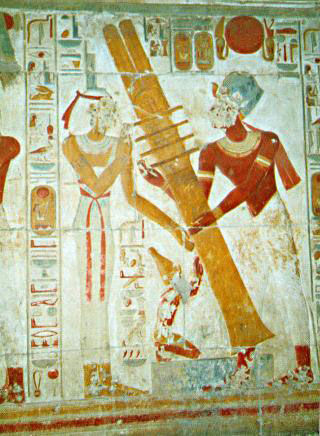 Other provocative aspects of
Osirisí murder involve the recurring
frequency of certain literary metaphors, like "a floating wooden
coffin" ... its eventual internment "in a tree in Lebanon"
(ultimately "cut down" and turned into a "pillar" -- i.e. a
"support") ... and the repeated raising of this transformed, now
sacred "Djed Pillar," to 'resurrect Osiris' at Abydos (left). Other provocative aspects of
Osirisí murder involve the recurring
frequency of certain literary metaphors, like "a floating wooden
coffin" ... its eventual internment "in a tree in Lebanon"
(ultimately "cut down" and turned into a "pillar" -- i.e. a
"support") ... and the repeated raising of this transformed, now
sacred "Djed Pillar," to 'resurrect Osiris' at Abydos (left).
[Fascinatingly, this inanimate object, with four completely
mysterious 'flanges' (signifying four prior 'pole shifts,' analogous
to the Hopi/Maya/Aztec/Inca previous 'Four Worlds'?) -- eventually
becomes synonymous with the resurrected "god" - "Osiris" --
himself!].
What is especially provocative is that these striking Osirian
references directly connect (in the Hyperdimensional model) not just
to the idea of Precession -- but to the much more disturbing idea of
sudden, semi-periodic axial shifts in Earthís rotation (somehow,
triggered by this same slow "wobbling" of the Earth!). Shifts which
brings with them enormous world-wide destruction and devastation -
via water (the inevitable, sloshing oceans -).
Examples--
- Osirisí annual Processional statute arriving at
Abydos by water
-
Set imprisoning him within a "floating coffin" - on the water - The
annual Abydos Procession, culminating with his joyous Resurrection
and return to rightful Rulership by boat - over water -
All these and other curious associations (for an "underground" god),
of "Osiris and water," have been casually accepted by Egyptologists
for centuries, but their global significance has apparently been
completely overlooked. This includes the following, remarkable
reference in the
Pyramid Texts themselves:
"O Osiris the King, arise, lift yourself up ... Your sisters Isis
and Nepthys come to you that they may make you healthy, and you are
complete and great in your name of íWall of the Bitter Lakesí, you
are healthy and great in your name of íSeaí; behold, you are great
and round in your name íOceaní; behold you are circular and round as
the circle which surrounds the Hw-nbwt; behold you are round and
great as the Sn-sk [emphasis added] ..."
The renowned Egyptologist,
R. O. Faulkner, in translating the
Pyramid Texts, was particularly struck by this reference to Osiris
being "circular and round." He was so intrigued that he attached a
special commentary, attempting to explain it as "the kingís
authority and power being all-embracing and universal."
Obviously, he completely missed the point: Osiris, in these
passages, is not only being directly identified with the Ocean ...
but with the added, redundant detail that it (he) was "great and
round" ... precisely like the ocean which surrounds our "great and
round" planet. Clearly, this is a descriptive detail the authors of
the Pyramid Texts in no way should not have known!
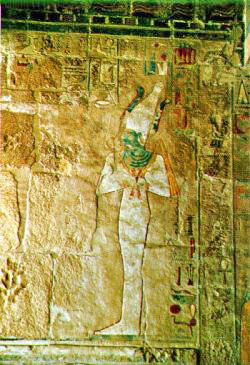 And, of course, standard Egyptologists are not for an instant going
to appreciate an alternative interpretation for this knowledge;
coming as they do from a hundred year perspective that these texts
originated in a primitive, agrarian society [not by accident was
Osiris also represented as "the green god," because of his
identification with early Egyptian agriculture (right)], they
universally believe, like Faulkner, that these unusual references
simply have to be just literary metaphors for ... "kingly powers." And, of course, standard Egyptologists are not for an instant going
to appreciate an alternative interpretation for this knowledge;
coming as they do from a hundred year perspective that these texts
originated in a primitive, agrarian society [not by accident was
Osiris also represented as "the green god," because of his
identification with early Egyptian agriculture (right)], they
universally believe, like Faulkner, that these unusual references
simply have to be just literary metaphors for ... "kingly powers."
Literally beyond their comprehension is the possibility that these
carefully repeated phrases (and a litany of others) are, in fact,
cleverly disguised code ... meant only for "initiates," and signify
other awesome possibilities ...
(In fairness, one should cite at least one scholar, Richard
Wilkinson, whoís found Osirisí repeated textual associations with
"water" indicative of some kind of "manifestation of deeper cosmogenic imagery." At least heís closer!)
Even more direct is another quote from the Texts:
"I have come into the Island of Fire, I have set right in it, in the
place of wrong, and I am on my way to the linen garments which the
uraei guard on the night of the Great Flood which came forth from
the Great One [Osiris] ... [emphasis added]."
And, finally, from a contemporary "high-culture" several hundred
miles to the east of Egypt, we find this remarkable reference.
As weíve established earlier, in Egyptian, Osirisí actual name is
"üsar." In the well-known Babylonian creation myth
The Enuma Elish,
one of the creator god Mardukís sacred fifty names was A.SAR ...
meaning...
"Great Watery King."
üsar ... A.SAR. And no one, before now, seems to have noticed the
remarkable "coincidence"...
Further linkage to a possible catastrophe in the Egyptian myths is
the mystifying association of this Event with the continuing
metaphor of "cut-down trees" (i.e. the death of "Life?")
transforming into "pillars" (a fundamental axial support?). This is
followed by the need to constantly reerect 'the Djed Pillar' (the
previous axial support?) -- to successfully complete the
'resurrection' of Osiris.
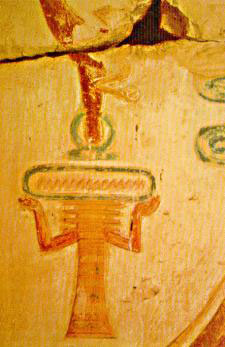 Similar metaphors are cited again and again in "Hamletís Mill" as
universal literary themes around the world. In Santillana and
Von Dechends epic tome, they are signaled as potential codes for none
other than the previously stable rotation of the Heavens (Earth), on
an axis represented by a pillar or a tree - and the vital need to
reestablish that stability (resurrect society, 'Osiris') after its
sudden, catastrophic shift (death!). The great mythologist, Joseph
Campbell, writing on this recurring world-wide image, firmly
believed: Similar metaphors are cited again and again in "Hamletís Mill" as
universal literary themes around the world. In Santillana and
Von Dechends epic tome, they are signaled as potential codes for none
other than the previously stable rotation of the Heavens (Earth), on
an axis represented by a pillar or a tree - and the vital need to
reestablish that stability (resurrect society, 'Osiris') after its
sudden, catastrophic shift (death!). The great mythologist, Joseph
Campbell, writing on this recurring world-wide image, firmly
believed:
"... its symbolic function, as representing the axial height joining
earth and sky, is evident [emphasis added].
In the Egyptian usage, some representations of the
Djed Pillar show
it with a pair of curious "stabilizing arms and hands"
(image right) -- an
obvious visual allusion to the axisí disturbing tendency to suddenly
and unpredictably shift ... "without a steadying pharaonic
influence." This particular Djed image was used throughout the
still-mysterious (to most Egyptologists) Heb-Sed ritual -- a major
ceremony crucial to periodically renewing a pharaohís god-like
powers, particularly, in maintaining the stability of this vital
"bond between Heaven and Earth."
In other words, the Osiris Myths actually seem to be a "coded" means
of quietly communicating to the "in crowd" then and now! --
ancient, "secret knowledge" of the fundamental relationship between
the long-term Precessing Earth, and the semi-periodic,
"Hyperdimensional hiccups" that can occur in this Precession ...
which cause radical short-term, catastrophic changes in the overall
axial orientation of the Earth ...
(And that is NOT in "Hamletís Mill!")
(Continued in Part VI)
|
 "First of all, the plan of the building is not the customary
rectangle but is shaped like a capital letter íLí (right). But this
does not seem to have been premeditated. The width of the short arm
of the íLí is exactly the width of the main part. Moreover, the
chambers in it should normally be at the extreme western end of
the building behind what is now called the íOsiris Complex.í
Furthermore, the thickness of the wall dividing the Chapel of Sety,
and the chapels of the Statue Hall from the Hall of Soker and its
chapels is the same as that of the outer southern wall of the two
hypostyle halls and the two courts. In other words, that was the
original southern exterior wall of the building; and all of the
rooms to the south of it [the lower part of the íLí -- above] are
additions.
"First of all, the plan of the building is not the customary
rectangle but is shaped like a capital letter íLí (right). But this
does not seem to have been premeditated. The width of the short arm
of the íLí is exactly the width of the main part. Moreover, the
chambers in it should normally be at the extreme western end of
the building behind what is now called the íOsiris Complex.í
Furthermore, the thickness of the wall dividing the Chapel of Sety,
and the chapels of the Statue Hall from the Hall of Soker and its
chapels is the same as that of the outer southern wall of the two
hypostyle halls and the two courts. In other words, that was the
original southern exterior wall of the building; and all of the
rooms to the south of it [the lower part of the íLí -- above] are
additions.
 The reason is also
quite obvious: close proximity to a previous
"sacred complex" dedicated to Osiris -- perchance, to
Osiris "burial
tomb" itself! -- would (via sympathetic "magic") only enhance Setiís
own "connection" to Osiris. And it was on that connection that the
well-being of the entire Kingdom, according to Egyptian beliefs,
ultimately depended ...
The reason is also
quite obvious: close proximity to a previous
"sacred complex" dedicated to Osiris -- perchance, to
Osiris "burial
tomb" itself! -- would (via sympathetic "magic") only enhance Setiís
own "connection" to Osiris. And it was on that connection that the
well-being of the entire Kingdom, according to Egyptian beliefs,
ultimately depended ... "When he became King,
Sety (right from his Temple) chose as one of
his official names, Wehem-musut, which means, íRepeating Births,í
or, in other words, íRenaissanceí; and this name was a proclamation
of his policy. For Sety had inherited a kingdom riddled with
corruption despite the unceasing efforts of Hor-em-heb to clean up
the government departments. Egyptís Asiatic Empire had vanished, her
frontiers were threatened and even her ago-old claim on the Sinai
Peninsula was disputed by roving bands ...
"When he became King,
Sety (right from his Temple) chose as one of
his official names, Wehem-musut, which means, íRepeating Births,í
or, in other words, íRenaissanceí; and this name was a proclamation
of his policy. For Sety had inherited a kingdom riddled with
corruption despite the unceasing efforts of Hor-em-heb to clean up
the government departments. Egyptís Asiatic Empire had vanished, her
frontiers were threatened and even her ago-old claim on the Sinai
Peninsula was disputed by roving bands ... "Thus most of the first half of Setyís twenty-one year reign was
occupied in settling the unrest in the Middle East. Only then did he
feel free to embark on his great building schemes ... To him we owe
the completion of the building of the great hypostle hall at Karnak
(begun by Hor-em-heb), the Temple of Gourna and additions to many
existing temples. But his greatest artistic triumph into which he
had put his whole heart, soul and energy is his beautiful temple at
Abydos (left). The whole building stands as witness to his reverence
for the gods and his love of sheer beauty ...
"Thus most of the first half of Setyís twenty-one year reign was
occupied in settling the unrest in the Middle East. Only then did he
feel free to embark on his great building schemes ... To him we owe
the completion of the building of the great hypostle hall at Karnak
(begun by Hor-em-heb), the Temple of Gourna and additions to many
existing temples. But his greatest artistic triumph into which he
had put his whole heart, soul and energy is his beautiful temple at
Abydos (left). The whole building stands as witness to his reverence
for the gods and his love of sheer beauty ...
 In the version of the murder where Set gathers his cohorts together
for a Feast "in honor of Osiris," and then invites the unsuspecting
god to get into a carefully guilded box (which will ultimately
become his coffin -- when itís sealed and cast into the Nile, with
him inside!), the myth makes particular reference to the number of
Setís "co-conspirators" gathered at the "Feast":
72. Not 71 ... or
73. But 72.
In the version of the murder where Set gathers his cohorts together
for a Feast "in honor of Osiris," and then invites the unsuspecting
god to get into a carefully guilded box (which will ultimately
become his coffin -- when itís sealed and cast into the Nile, with
him inside!), the myth makes particular reference to the number of
Setís "co-conspirators" gathered at the "Feast":
72. Not 71 ... or
73. But 72. For several years, we at
'Enterprise' have been looking into a
"Hyperdimensional" reason for this fundamental motion of the Earth.
This, as opposed to the commonly accepted theory -- that it is the
Moonís simple gravitational pull, tugging on the slightly bulging
equator of the Earth, which causes its Precession (directly
analogous to the Earthís own gravity pulling down on the precessing
top).
For several years, we at
'Enterprise' have been looking into a
"Hyperdimensional" reason for this fundamental motion of the Earth.
This, as opposed to the commonly accepted theory -- that it is the
Moonís simple gravitational pull, tugging on the slightly bulging
equator of the Earth, which causes its Precession (directly
analogous to the Earthís own gravity pulling down on the precessing
top).  I am certainly not the first to notice the potential for hidden
'Precessional' codes and numbers in the various Osirisí Myths
(image left).
I am certainly not the first to notice the potential for hidden
'Precessional' codes and numbers in the various Osirisí Myths
(image left).
 Other provocative aspects of
Osirisí murder involve the recurring
frequency of certain literary metaphors, like "a floating wooden
coffin" ... its eventual internment "in a tree in Lebanon"
(ultimately "cut down" and turned into a "pillar" -- i.e. a
"support") ... and the repeated raising of this transformed, now
sacred "Djed Pillar," to 'resurrect Osiris' at Abydos (left).
Other provocative aspects of
Osirisí murder involve the recurring
frequency of certain literary metaphors, like "a floating wooden
coffin" ... its eventual internment "in a tree in Lebanon"
(ultimately "cut down" and turned into a "pillar" -- i.e. a
"support") ... and the repeated raising of this transformed, now
sacred "Djed Pillar," to 'resurrect Osiris' at Abydos (left). And, of course, standard Egyptologists are not for an instant going
to appreciate an alternative interpretation for this knowledge;
coming as they do from a hundred year perspective that these texts
originated in a primitive, agrarian society [not by accident was
Osiris also represented as "the green god," because of his
identification with early Egyptian agriculture (right)], they
universally believe, like Faulkner, that these unusual references
simply have to be just literary metaphors for ... "kingly powers."
And, of course, standard Egyptologists are not for an instant going
to appreciate an alternative interpretation for this knowledge;
coming as they do from a hundred year perspective that these texts
originated in a primitive, agrarian society [not by accident was
Osiris also represented as "the green god," because of his
identification with early Egyptian agriculture (right)], they
universally believe, like Faulkner, that these unusual references
simply have to be just literary metaphors for ... "kingly powers."
 Similar metaphors are cited again and again in "Hamletís Mill" as
universal literary themes around the world. In Santillana and
Von Dechends epic tome, they are signaled as potential codes for none
other than the previously stable rotation of the Heavens (Earth), on
an axis represented by a pillar or a tree - and the vital need to
reestablish that stability (resurrect society, 'Osiris') after its
sudden, catastrophic shift (death!). The great mythologist, Joseph
Campbell, writing on this recurring world-wide image, firmly
believed:
Similar metaphors are cited again and again in "Hamletís Mill" as
universal literary themes around the world. In Santillana and
Von Dechends epic tome, they are signaled as potential codes for none
other than the previously stable rotation of the Heavens (Earth), on
an axis represented by a pillar or a tree - and the vital need to
reestablish that stability (resurrect society, 'Osiris') after its
sudden, catastrophic shift (death!). The great mythologist, Joseph
Campbell, writing on this recurring world-wide image, firmly
believed: